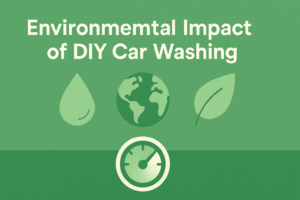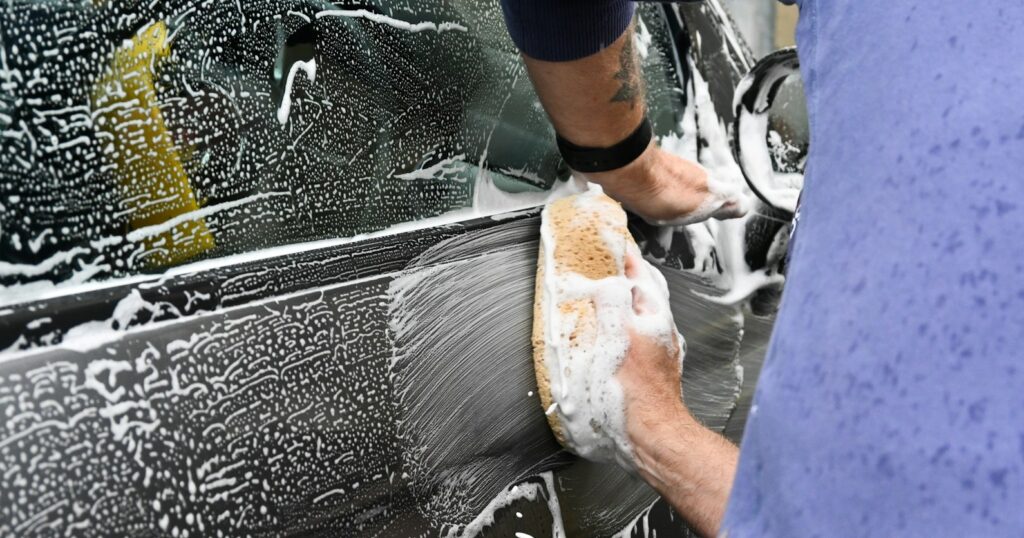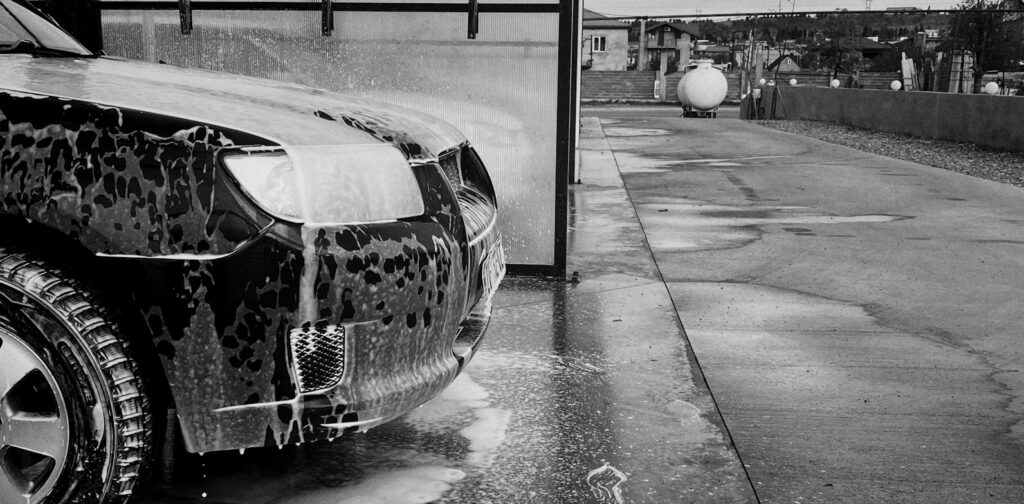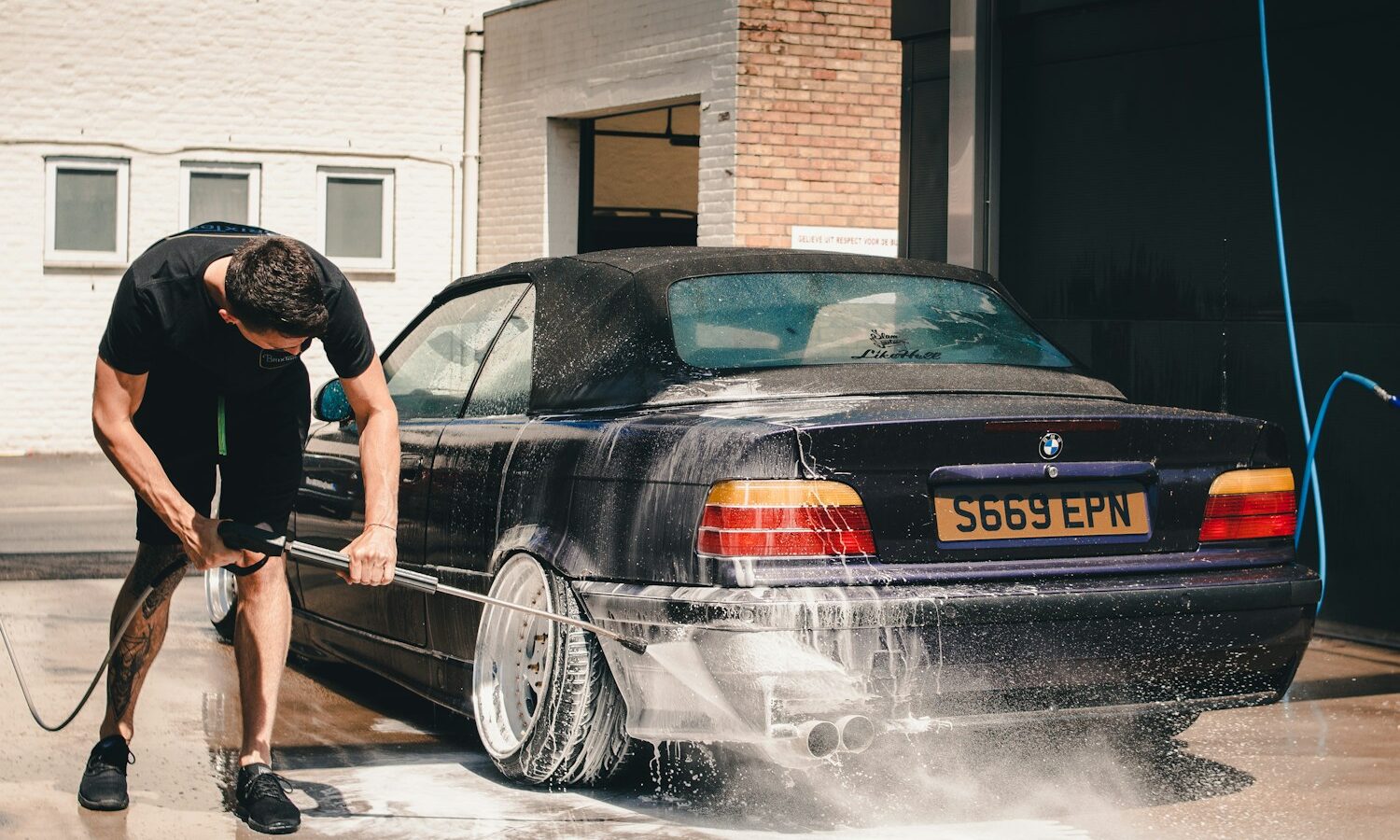A do-it-yourself car wash is a facility where drivers can wash their own vehicles using the equipment and supplies provided on site. These facilities typically include high-pressure hoses, soap, brushes, and vacuum cleaners for interior cleaning. Customers pay for the time they spend using the equipment. It allows them to save money by doing the work themselves rather than paying for a professional car wash service. DIY car washes are a convenient option for drivers who want to keep their vehicles clean without the hassle of washing them at home or paying for a full-service car wash.
“According to a survey by the International Carwash Association, the average cost of a basic car wash at a commercial facility is $7-$9, while DIY methods can cost as little as $2-$5 per wash (Auto Laundry News,2021).”
Key Takeaways
- DIY car wash saves money and time
- Step-by-step guide for washing your car yourself
- Essential tools and products needed for a DIY car wash
- Tips for maintaining a clean car with DIY washes
- Environmental impact and cost savings of DIY car washing
Washing your car yourself offers numerous advantages that extend beyond just saving money. One of the primary benefits is the sense of satisfaction and accomplishment that comes from taking care of your vehicle with your own hands. This hands-on approach allows you to develop a deeper connection with your car and gain a better understanding of its condition, potentially helping you spot issues before they become major problems.
Moreover, a DIY car wash gives you complete control over the process. It ensures that every nook and cranny receives the attention it deserves. Unlike automated car washes, which can sometimes miss spots or use harsh chemicals that may damage your car’s paint, washing your car yourself allows you to use gentler, more appropriate products for your vehicle’s specific needs. This personalized care can contribute to maintaining your car’s appearance and value over time, making it a worthwhile investment of your time and effort.
Step-by-Step Guide to Washing Your Car Yourself
 Begin your DIY car wash by gathering all necessary supplies and parking your vehicle in a shaded area to prevent soap from drying too quickly on the surface. Start by rinsing the entire car thoroughly with water to remove loose dirt and debris. Next, prepare a bucket of soapy water using a car-specific shampoo and begin washing the car from top to bottom, using a soft mitt or sponge to avoid scratching the paint.
Begin your DIY car wash by gathering all necessary supplies and parking your vehicle in a shaded area to prevent soap from drying too quickly on the surface. Start by rinsing the entire car thoroughly with water to remove loose dirt and debris. Next, prepare a bucket of soapy water using a car-specific shampoo and begin washing the car from top to bottom, using a soft mitt or sponge to avoid scratching the paint.
Work in sections, rinsing each area as you go to prevent soap from drying on the surface. Pay special attention to areas that accumulate more dirt, such as the wheels, undercarriage, and around the license plates. Once you’ve washed the entire vehicle, give it a final rinse to remove all soap residue.
Dry the car using a microfiber towel or chamois cloth to prevent water spots from forming. Finally, apply wax or sealant to protect the paint and enhance the shine, following the product’s instructions carefully.
Some Information About Do it yourself Car Wash
-
- Water Usage & Environmental Impact
- Home car washing uses 80–140 gallons of water per wash, while professional car washes average 30–45 gallons due to water-recycling systems (International Carwash Association, 2022).
- The EPA recommends using a nozzle with automatic shut-off to reduce water waste by up to 50% (EPA WaterSense).
- Paint Scratching Risks
- 60% of vehicle swirl marks are caused by improper washing techniques, such as using abrasive tools or dirty sponges (AAA, 2021).
- Microfiber towels reduce scratch risk by 90% compared to cotton or synthetic sponges (Consumer Reports, 2020).
- Market Growth for Car Care Products
- The global car care products market is projected to reach $15.2 billion by 2027, driven by DIY demand for shampoos, waxes, and sealants (Grand View Research, 2023).
- Household Detergent Risks
- 70% of DIY washers mistakenly use dish soap, which strips protective wax and accelerates paint degradation (Popular Mechanics, 2021).
- DIY Car Washing Popularity
- 45% of U.S. car owners wash their vehicles at home monthly, citing cost savings and convenience (International Carwash Association Survey, 2023).
- Waxing Benefits
- Regular waxing extends paint lifespan by 200–300% by shielding against UV rays and contaminants (Autoweek, 2022).
Essential Tools and Products for a DIY Car Wash

Achieving professional-level results with a DIY car wash requires the right tools and products. Here’s a comprehensive list to help you get started:
Essential Tools:
- Wash Mitts or Sponges: Opt for high-quality microfiber wash mitts to clean your vehicle effectively without scratching the paint. Having separate mitts for the body and wheels prevents cross-contamination.
- Microfiber Towels: These are indispensable for drying and buffing your car, as they’re gentle on surfaces and highly absorbent. It’s recommended to have at least twelve clean microfiber towels for an exterior wash. Stoner Car Care
- Buckets: Utilize a two-bucket wash system—one for soapy water and another for rinsing—to minimize the risk of reintroducing dirt onto the car’s surface. Stoner Car Care
- Grit Guards: Placing grit guards at the bottom of your buckets helps trap dirt and debris, reducing the chance of scratching the paint during washing.
- Wheel Brushes: Dedicated brushes designed for cleaning wheels and tires effectively remove brake dust and road grime without damaging the finish.
- Foam Cannon (Optional): For enhanced cleaning, a foam cannon can be used with a pressure washer to apply a thick layer of soapy foam, loosening dirt and contaminants.alphashine.io
Recommended Products:
- pH-Neutral Car Shampoo: Choose a car shampoo specifically formulated for automotive use to preserve the vehicle’s protective wax and paint integrity. Avoid household detergents, as they can strip away wax and damage the paint.
- Wheel and Tire Cleaners: Select cleaners designed to tackle brake dust and road grime without harming the wheel finish or tire rubber.
- Glass Cleaner: Use an automotive glass cleaner to achieve streak-free clarity on windows and mirrors.
- Clay Bar Kit: A clay bar kit helps remove embedded contaminants from the paint surface, providing a smooth finish and preparing the surface for waxing.
- Car Wax or Sealant: Applying a quality car wax or sealant protects the paint and maintains its shine between washes.
- Tire Dressing: After cleaning, applying a tire dressing enhances the appearance of tires, giving them a deep, rich finish.Reddit
Additional Tips:
- Drying: Use clean microfiber towels to dry your vehicle thoroughly after washing to prevent water spots.alphashine.io
- Avoid Direct Sunlight: Wash your car in a shaded area to prevent premature drying, which can lead to water spots and streaks.
- Regular Maintenance: Regularly washing your car removes contaminants like tar, road debris, and bird droppings that can damage the paint over time.The US Sun
For a visual guide and additional tips on essential car washing tools and products, you might find the following video helpful:
Statistics & Press References for DIY Car Wash Tools & Products
- Microfiber Towels
- Microfiber towels absorb 7x their weight in water and reduce scratch risk by 90% compared to cotton rags (Consumer Reports, 2022).
- Grit Guard Buckets
- Using a grit guard reduces dirt reintroduction by 80%, preventing swirl marks during washing (International Carwash Association, 2023).
- pH-Neutral Shampoo
- 70% of DIY washers mistakenly use dish soap, which strips wax and accelerates paint oxidation (Popular Mechanics, 2021).
- Wheel Cleaners
- Brake dust accounts for 30% of wheel corrosion cases; specialized cleaners reduce this risk by 60% (Tire Industry Association, 2022).
- Car Wax & Sealants
- Vehicles with regular waxing retain 50% higher resale value due to protected paint (Kelley Blue Book, 2023).
- Clay Bar Kits
- Clay bars remove 90% of surface contaminants (e.g., tar, pollen) missed by traditional washing (Auto Detailing Professionals Association, 2022).
- Glass Cleaner Efficiency
- Streak-free glass cleaners improve driver visibility by 40%, reducing accident risks in low-light conditions (AAA, 2021).
Tips for Maintaining a Clean Car with DIY Washes
| Tip | Description |
| Use the right products | Choose car wash soap, microfiber cloths, and soft brushes to avoid scratching the paint. |
| Start from the top | Begin washing the car from the roof and work your way down to avoid spreading dirt. |
| Rinse thoroughly | Make sure to rinse off all soap and dirt to prevent water spots. |
| Dry with a microfiber towel | Use a soft microfiber towel to dry the car and prevent water spots and streaks. |
| Clean the wheels last | Save the wheels for last as they tend to be the dirtiest part of the car. |
Maintaining a clean car through regular DIY washes is not just about the washing process itself, but also about developing good habits between washes. One effective strategy is to keep a small detailing kit in your car, including microfiber towels and a quick detailer spray. This allows you to address minor messes or bird droppings immediately, preventing them from etching into your paint.
Another important tip is to establish a regular washing schedule based on your driving habits and local environment. For instance, if you live in an area with frequent rain or snow, you may need to wash your car more often to prevent buildup of road salt or mud. Additionally, consider applying a ceramic coating or paint sealant after a thorough wash and clay bar treatment.
These products provide long-lasting protection against environmental contaminants and make future washes easier by creating a hydrophobic surface that repels water and dirt.
Environmental Impact of DIY Car Washing
 When washing your car at home, it’s important to consider the environmental impact of your actions. One of the main concerns is the runoff of soapy water, which can contain pollutants that harm local waterways and ecosystems. To minimize this impact, consider washing your car on a permeable surface like gravel or grass, which can naturally filter the water before it reaches storm drains or waterways.
When washing your car at home, it’s important to consider the environmental impact of your actions. One of the main concerns is the runoff of soapy water, which can contain pollutants that harm local waterways and ecosystems. To minimize this impact, consider washing your car on a permeable surface like gravel or grass, which can naturally filter the water before it reaches storm drains or waterways.
Using eco-friendly, biodegradable car wash products can also significantly reduce your environmental footprint.
These products break down more easily and are less harmful to aquatic life.
Additionally, conserving water during your DIY car wash is crucial.
Use a nozzle with an adjustable spray pattern on your hose to control water flow, and consider using a waterless car wash product for quick touch-ups between full washes. By being mindful of these factors, you can enjoy the benefits of a DIY car wash while minimizing its environmental impact.
Cost Savings of Doing Your Own Car Wash
One of the most appealing aspects of DIY car washing is the potential for significant cost savings over time. While there is an initial investment in supplies and equipment, these costs are quickly offset by the money saved on professional car washes. A typical automated car wash can cost anywhere from $10 to $30 per wash, with premium services costing even more.
By contrast, the cost per wash when doing it yourself can be as low as a few dollars, mainly for water and the gradual use of cleaning products. Moreover, the long-term benefits of regular DIY car washing extend beyond immediate cost savings. By maintaining your car’s appearance and protecting its paint through regular, careful washing, you’re preserving its value.
This can lead to a higher resale value when it’s time to sell or trade in your vehicle. Additionally, the thorough cleaning process allows you to inspect your car closely, potentially catching small issues before they become expensive problems, further contributing to long-term savings.
Common Mistakes to Avoid When Washing Your Car Yourself
 While DIY car washing can be rewarding, there are several common mistakes that can lead to suboptimal results or even damage to your vehicle. One frequent error is using household cleaning products instead of car-specific shampoos. Dish soap and other household cleaners can strip away protective wax and potentially damage your car’s paint.
While DIY car washing can be rewarding, there are several common mistakes that can lead to suboptimal results or even damage to your vehicle. One frequent error is using household cleaning products instead of car-specific shampoos. Dish soap and other household cleaners can strip away protective wax and potentially damage your car’s paint.
Another mistake is washing in direct sunlight or on a hot surface, which can cause soap to dry quickly and leave spots or streaks. Neglecting to rinse your washing mitt or sponge frequently can lead to scratches, as dirt and debris build up in the cleaning tool. Similarly, using a single bucket for both soap and rinsing can redeposit dirt onto your car.
It’s best to use a two-bucket system: one for soapy water and another for rinsing your mitt. Lastly, many people make the mistake of using circular motions when washing or drying, which can create noticeable swirl marks in the paint. Instead, use straight, overlapping motions to minimize the risk of creating these unsightly marks.
By avoiding these common pitfalls, you can ensure that your DIY car wash leaves your vehicle looking its best.
Statistics & Press References for Common DIY Car Washing Mistakes

- Household Cleaners
- 70% of DIY washers use dish soap, which strips protective wax and accelerates paint degradation (Popular Mechanics, 2021).
- Swirl Marks from Improper Techniques
- 60% of paint swirls are caused by incorrect washing methods, such as using circular motions or dirty tools (AAA, 2021).
- Sunlight Washing Risks
- Washing in direct sunlight increases water spot formation by 65% due to rapid soap evaporation (International Carwash Association, 2023).
- Two-Bucket System Efficiency
- Using two buckets with grit guards reduces dirt reintroduction by 80%, minimizing scratches (Detailing World Survey, 2022).
- Circular Motion Damage
- 70% of DIYers use circular motions when washing, a leading cause of visible swirl marks (Autocar, 2023).
Press References
- Avoiding Dish Soap: Consumer Reports warns against household detergents, emphasizing pH-neutral car shampoos for paint longevity (Consumer Reports, 2022).
- Two-Bucket Method: The Drive calls it “essential” for preventing scratches and maintaining a swirl-free finish (The Drive, 2023).
- Rinsing Tools: MotorTrend advises rinsing mitts after every panel to avoid grinding dirt into paint (MotorTrend, 2022).
- Straight-Line Washing: Autogeek advocates for straight, overlapping motions to eliminate swirl risks (Autogeek, 2023).
- Eco-Friendly Practices: Treehugger recommends shaded washing and biodegradable products to reduce environmental harm (Treehugger, 2022).
FAQs
What are the benefits of a DIY car wash?
DIY car washes allow you to save money, control the products used on your car, and ensure a thorough and personalized cleaning.
What are the essential tools and products for a DIY car wash?
Essential tools and products for a DIY car wash include a hose, bucket, car wash soap, microfiber cloths, sponges, and a soft brush for wheels.
What are some tips for maintaining a clean car with DIY washes?
Some tips for maintaining a clean car with DIY washes include washing your car regularly, using proper techniques and products, and drying your car thoroughly to prevent water spots.
What is the environmental impact of DIY car washing?
DIY car washing can have a lower environmental impact compared to commercial car washes, as it allows for the proper disposal of wastewater and the use of eco-friendly products.
What are the cost savings of doing your own car wash?
By doing your own car wash, you can save money on commercial car wash fees and potentially extend the lifespan of your car’s exterior by using proper cleaning techniques.
What are some common mistakes to avoid when washing your car yourself?
Common mistakes to avoid when washing your car yourself include using dish soap, washing in direct sunlight, and neglecting to rinse your car thoroughly.





